
7 minute read
Editorial
Editorial
Vedantic Secularism
Advertisement
Recently when The Vedanta Kesari volunteers approached a private educational institution offering the ‘VK for Students Scheme’, the principal quickly dismissed the proposal as unbefitting the ‘secular’ credentials of her institution. The free offer, which is for students from class 10 to degree college, requires the class teacher to recognise every month a boy and a girl who manifest noble characteristics like honesty, selflessness, self-control, and service, and gift them each a copy of The Vedanta Kesari. But the principal saw this gift as promotion of a religious ideology and therefore an unsecular activity.
Behind the Principal’s ‘secularist’ stance lies two reasons. The first is the unfortunate influence of the West where the academia largely rejected religion as unscientific thinking and mere rigid dogmas. But it should be noted that in our land, right from the Vedic times, religion has been upheld not as a finished dogma, but as “a method and a means to pierce the veil that hides the ever-present meaning and mystery of existence.” This religious approach encompasses all dimensions of life, all fields of knowledge. The Mundaka Upanishad declares that for a total understanding and development of life at the physical, mental, and moral levels, man should cultivate two kinds of knowledge – the para vidya or the supreme knowledge that unveils the eternal Truth behind the manifest life, and the apara vidya or the ordinary knowledge dealing with scriptures and all the sciences and arts of the perishable manifest world. Again, of the two vidyas, apara or Brahma vidya occupies the primary position because it is sarva-vidya-pratistha, the basis of all secular knowledge.
The second reason behind the ‘secularist’ rejection of religion in education, is that being a multi-religious country we cannot allow any one particular religion to shape the character of our children. Also, allowing all religions to have a say is not possible because they bring contradictory values and ideals. Indeed, no faith – which insists that its doctrines are the only true ones; which believes that those who do not believe in its doctrines will go to some terrible place; which even draws the sword to compel others to believe as it says; which demands that its God be accepted as the Supreme, – should have any say in the 21 st century education system.
But we are talking about Vedanta, the Universal Religion based on universal principles of life. Vedanta is a system of knowledge which is marked by a scientific spirit – a critical and bold inquiry into Truth made with objectivity and precision, and welcoming the challenge of verification. Vedanta is the pursuit of a unified vision and experience of life which naturally leads to spiritual growth within and social productivity and peace in the world outside.
If the State does not actively support and impart this Vedantic view of life in education and in the functioning of public institutions, a large number of our rapidly increasing population will grow up with a fundamentalist mind-set. They can at best only rise to the level of toleration, which is but only a mild form of violence.
We should remember that our traditions and value system are rooted in the pursuit of para vidya. Neglecting this spiritual tradition and denying it to our younger generation, will make us untrue to the growth of our civilisation since ages, and will only result in individual and social moral degeneration. For a deeper understanding of this topic see page 16 of this issue.
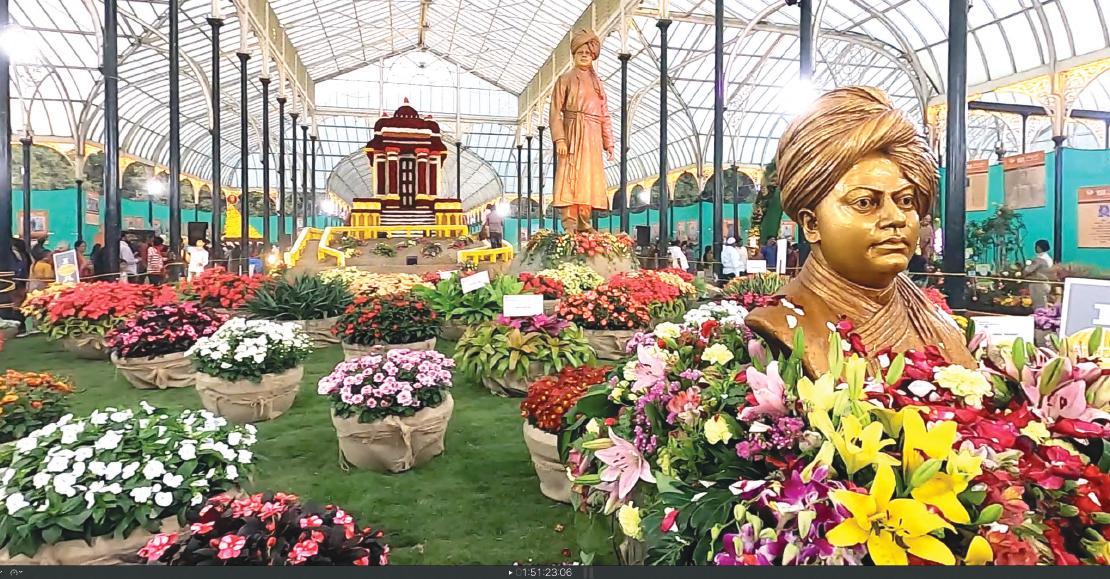
Bengaluru’s Floral Tribute to Swami Vivekananda
SURESH MOONA
A unique form of floral tribute was offered to Swami Vivekananda in January 2020 in the city of Bengaluru. A brief description of this Flower Show is presented here.
Since the time Kempe Gowda-I, a chieftain under the Vijayanagara
Empire, built Bengaluru in 1537, the city with its salubrious climate, greenery, and kind-hearted people has been steadily growing, attracting people and organisations from across the country and even abroad.
For the devotees and admirers of the Ramakrishna Order, there are two significant events in the history of Bengaluru: the first is Swami Vivekananda’s visit in 1892 and later Holy Mother Sri Sarada Devi’s visit in 1911. These two visits, along with the visits of other direct-disciples of Sri Ramakrishna – Swamis Brahmananda, Ramakrishnananda, Abhedananda, Shivananda, and Vijnanananda, made Bengaluru an important centre for spreading Ramakrishna-Vivekananda movement across Karnataka. One of the great maxims of Swamiji: “They alone live who live for others, the rest are more dead than alive” was written to Chamaraja Wadiyar, the Maharaja of Mysore. For more than a century, the people of Bengaluru have been paying tributes in various ways to Swami Vivekananda, the patriot-monk. Last January, a unique tribute was offered in the form of the Republic Day Flower Show, 2020 at Lalbagh. It was called Viveka Pushpa Namana or ‘Floral Respect to Vivekananda’, and held from 17 th to 26 th January 2020.
Lalbagh Garden was conceived by Hyder Ali in 1760 and completed by his son Tipu Sultan. It gradually developed into the present 240-acre botanical garden nurturing a variety of plants and trees. From 1912 Lalbagh began to organise flower shows. There were two annual flower shows, known as Summer Show and Winter Show. Since 1951, these shows are organised as Independence Day Show and Republic Day Show. These shows serve as a
The author is a noted scholar of the history of Bengaluru and a popular columnist. sureshmoona@gmail.com

medium to educate people about the variety of flora and develop public interest in plant conservation. The flower shows are organized in the Glasshouse which is also known as the The Jewel of Lalbagh; it ismodeled on London’s Crystal Palace and was built around 1889.
To commemorate the 157 th birth anniversary of Swami Vivekananda, the theme for this year’s Republic Day Flower Show was “Swami Vivekananda’s Life & Teachings”. Titled as ‘Viveka Pushpa Pradarshana’, the 211 th floral show recreated, using a wide variety of flowers, important incidents and places related to Swamiji.
The flower show was inaugurated by the Hon’ble Chief Minister of Karnataka, Sri B. S. Yediyurappa on 17 Jan 2020 in the presence of the chief guest, Sri V. Somanna, Minister for Housing, Horticulture and Sericulture, Government of Karnataka, and Swami Tadyuktananda of Ramakrishna Math
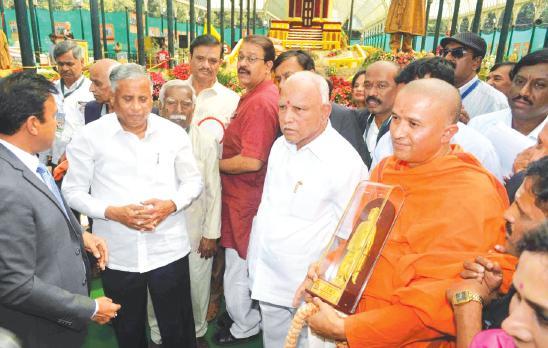
Sri B. S. Yediyurappa, Sri V. Somanna & Swami Tadyuktananda
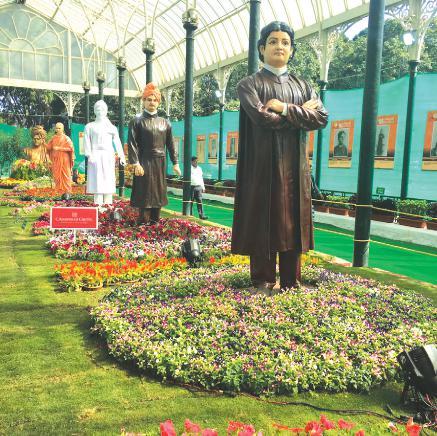
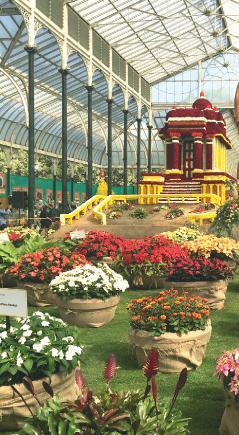
Basavanagudi, Bengaluru. The event was the joint effort of Sri Ramakrishna Vidyarthi Mandiram (SRVM), a unit of Ramakrishna Math, Basavanagudi and the Department of Horticulture, Government of Karnataka.
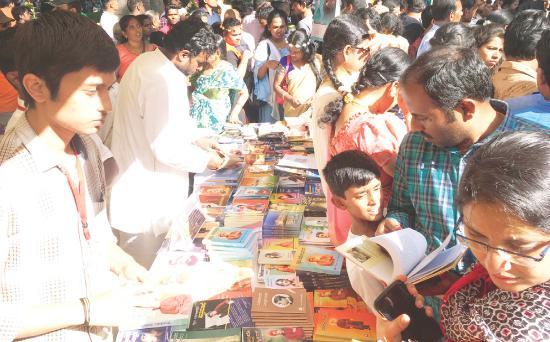
The Glass House
In the Glass House the presentations included floral replicas of (i) Swami Vivekananda Rock Memorial of Kanyakumari; (ii) the interior of Swami Vivekananda Temple at Belur Math; (iii) the podium from where Swamiji addressed the audience at the Chicago Parliament of Religions as “Sisters and Brothers of America” (with an audio rendering of his speech in the background); (iv) a vertical garden of the Swami Vivekananda Mantapa at the Ramakrishna Math, Bengaluru (with the stone bench on which Swamiji sat while staying in Bengaluru); (v) embossed sculptures of Swamiji; (vi) Swamiji’s statues in different
Book exhibition-cum-sale
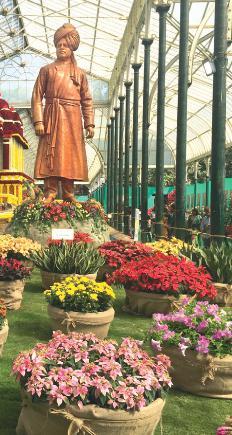

attires; (vii) 110 boards displaying Swamiji’s life and message; (viii) original pictures of Swamiji displayed on the walls of the Glass House; (ix) floral arrangement by many organisations with different themes; and (x) a display of 2000 exotic flowers.
Attractions in the garden
A number of activities and programmes were conducted in the park. A drawing competition on Swami Vivekananda was held in which 1300 students from class 1 to class 10 participated on 16 January. A film show on the life of Swami Vivekananda was held at the Kuteera near the Bonsai circle. SRVM and Ramakrishna Math, Basavanagudi screened a documentary film on Swamiji and his famous lectures. These films were shown on wide screens near the Glass House and Bonsai circle.
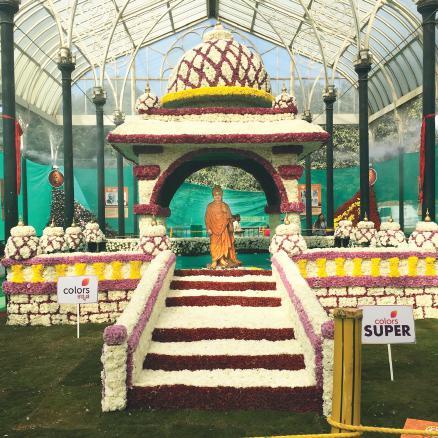
SRVM arranged a book exhibition-cum-sale in the garden. Near the Band Stand area, visuals using 60,000 Chrysanthemum flowers depicted the moral stories narrated by Swamiji in his lectures. Around 200 posters with attractive floral arrangement displayed powerful statements of Swamiji. Electric poles, ornamental poles, and trees all around Lalbagh displayed Swamiji’s quotations.
Every evening from 4.00 pm to 6.30 pm, SRVM arranged cultural programmes in which eminent artists and speakers presented bhajans, Vedic chantings, monoacting, classical music, classical dance, and martial arts.
The Viveka Pushpa Pradarshana attracted over 3 lakh visitors. This crowd, and the wide media coverage rekindled the life and message of Swami Vivekananda in the minds and hearts of the people of Bengaluru.


Cultural programmes







